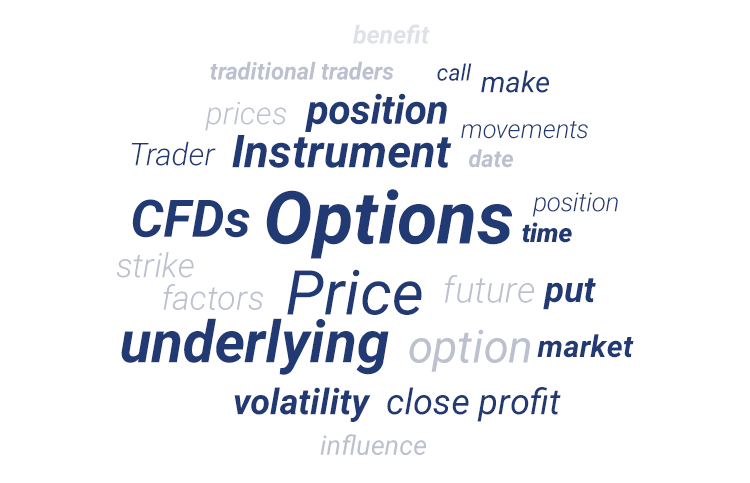What Factors Influence Options CFD Prices?
Option CFD prices are based on the price of market traded options. To understand how Option CFD prices are derived on the Plus500 platform, we need to investigate how traditional Options are priced and factors that can influence this.
How are Options Priced?
The value of Options in the traditional market depends on variables such as the underlying instrument price, Strike Price, volatility and time to expiration. Traders can then analyse these variables and execute their analysis into trading strategies with the objective of maximising profits.
CFD Options take factors straight from the underlying instrument, including the underlying instrument’s market price and Strike Price. They are also influenced by the same market movements as traditional Options. When trading CFD Options, the main objective is to speculate on the price of the underlying instrument, and decide whether the price will either rise or fall before the expiration date. Then the trader has the “option” to close the position to make a profit or loss (depending on the underlying market movement).

What Affects an Option’s Value
Here is a breakdown of how an Option’s Value can be influenced:
The Underlying Instrument Price: CFD Options follow the underlying option’s market movements. Market movements reflect largely on the supply and demand of the underlying instrument. This in turn influences how a Call or Put Option behaves. When the price of the underlying instrument rises, Call Options usually trend upwards in value. This means that Call Options CFD buyers could benefit from the rising price of the underlying instrument, however, could also incur a loss if the price falls. Whereas, Put Options usually trend downwards in value when the underlying instrument price rises, therefore, Put Option buyers may benefit from a falling market price.
However, if the speculation isn’t correct and the stock price moves in the opposite direction, the option might lose value and the position will close at a loss.
Strike Price: When determining an Option’s value, the Strike Price is arguably the most important variable. The Strike Price is the price the underlying instrument must reach before the Option expires. Strike Prices are predetermined and are fixed before the contract begins. The price between the underlying instrument and the Strike Price is what determines the Option’s value. Options CFDs are also available on a variety of Strike Prices, however they cannot be exercised.
Volatility: The effect of volatility on an Option’s price relies on a measure called Historical Volatility (also known as Statistical Volatility). As the name suggests, it examines past price movements of the underlying instrument over a certain time period. Experienced traders will use Option pricing models to estimate future volatility during this time period. To understand this concept, a trader may work the pricing model backwards and examine all other variables to calculate the prediction. In the traditional market, these include calculating interest rates, dividends and time value. When volatility occurs, Options tend to incur more value. Option CFD prices react when the underlying instrument experiences volatility. This can cause the Option CFD price to fluctuate more than the underlying instrument.
Implied Volatility is a key measure that allows traders to speculate what future volatility might be. Traders view the likelihood of future price changes by examining the underlying instrument’s volatility behaviour in the current time frame. Historical Volatility measures past market changes.
Time Value: Time Value has two variables (this is assuming there have been no changes to the underlying instrument price and volatility levels): (1) time until expiration and (2) how close the Strike Price is to the underlying instrument price. The longer it is until the expiry date, the more time the market has to hit the strike price. Time Value can be different depending on how close the Strike Price is to the underlying instrument
Time Decay measures the rate of decreased value of an Option as the expiration approaches. This is due to less time being available to make a profit. In the last month before expiration, Time Decay will increase.
Final Thoughts
There are several factors that influence an Option’s price. In the traditional market, the main variables include the underlying instrument price, Strike Price, volatility and duration to expiration. In the CFD market, Options CFDs are derived from the underlying instrument, except the trader does not have the right to exercise the Option. Instead, the trader can make a profit or loss from the difference in the opening and closing price of a position. It is worth considering all these variables when deciding to open an Options CFD position.
